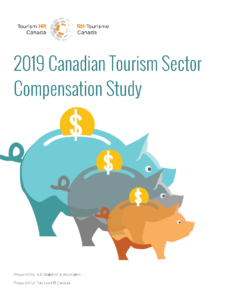 Tourism HR Canada is pleased to announce the 2019 Canadian Tourism Sector Compensation Study is now available.
Tourism HR Canada is pleased to announce the 2019 Canadian Tourism Sector Compensation Study is now available.
Employers in Canada’s tourism sector want to know they are offering competitive compensation strategies, just as workers and labour organizations want to know that they are receiving them. Having sound compensation data will help the tourism sector support a dynamic and balanced labour market.
Produced with R.A. Malatest and Associates, this comprehensive study presents data and analysis on the compensation and benefits offered by businesses in Canada’s tourism sector. Over 2,100 employers from across the country provided data for over 48,000 employees in food and beverage services, accommodation services, recreation and entertainment, and travel services.
The study contains information on the type of compensation (e.g., hourly or annual), salary range, median salary, and bonuses for 30 occupations in the sector. This data is broken down by region, industry group, employment status (full-time, part-time, seasonal), and union status.
The study also includes data on businesses’ policies around gratuities, benefits, perquisites and incentives. Additionally, in response to the changing landscape of compensation across the country, the study collected data on the impact of minimum wage increases on businesses in the sector.
Respondents were optimistic about the health of the sector. Overall, tourism businesses reported an increase in revenues in 2018 over the previous year. When asked about future demand, 21.9% expected to increase the size of their workforce in 2019, compared to only 6.3% who expected their workforce to shrink.
Understanding trends in compensation will help employers attract and retain the talent needed to continue to grow the sector and compete on an increasingly crowded global stage. The information contained in the Canadian Tourism Sector Compensation Study is essential for the development and implementation of consistent and effective human resource strategies. The data will help all tourism stakeholders set pay policies, develop evidence-based human resource strategies, and analyze competitive practices.
Access your copy of the 2019 Canadian Tourism Sector Compensation Study now.
Note: If you participated in the Canadian Tourism Sector Compensation Study survey in 2018, please contact research@tourismhr.ca for your complimentary copy of the study.
Fast Facts
- Nationally, the highest paying occupation receiving an annual salary was director of sales and marketing. The highest paying frontline position receiving an hourly wage was sous chef.
- The most common benefits offered were group health/dental insurance, life insurance, and short-term disability. The most common perks included employee discounts or free services, flex time, and communications technology.
- Almost three-quarters of respondents had staff who received gratuities, but only half had a gratuity splitting policy.
- Businesses in British Columbia and Ontario were more likely than those in Alberta to report they were able to absorb the costs of minimum wage increases.
- Among the changes implemented to help manage the increases, the most common was charging higher prices.

